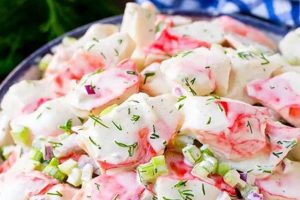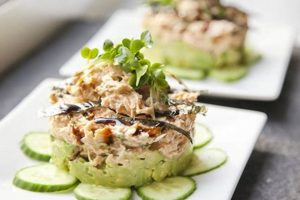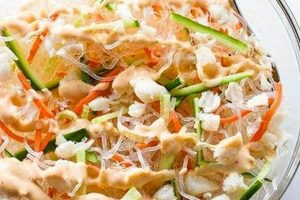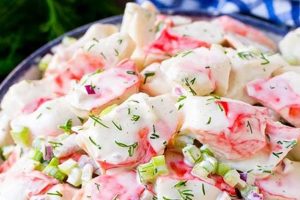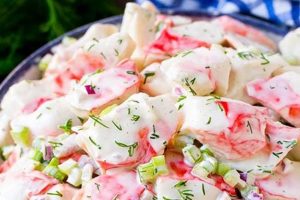Dishes featuring a blend of shredded imitation crab, often called surimi, combined with mayonnaise and various other ingredients like celery, onion, and seasonings, constitute a popular and affordable alternative to traditional crab salads. A simple version might involve mixing surimi with mayonnaise, celery, and a touch of lemon juice. More complex variations can incorporate hard-boiled eggs, Dijon mustard, Old Bay seasoning, or even fresh herbs.
The accessibility and lower cost of surimi compared to fresh crab make these salads an attractive option for budget-conscious consumers. Surimi also offers a milder flavor profile, appealing to those who find the taste of fresh crab too strong. Furthermore, its consistent texture and pre-cooked nature simplify preparation, making these salads quick and easy to assemble. While imitation crab’s use in salads dates back to the broader popularization of surimi in the late 20th century, it continues to be a convenient and widely enjoyed ingredient.
The following sections will explore diverse preparations, from classic recipes to innovative variations, offering guidance on ingredient selection, preparation techniques, and presentation suggestions. Nutritional information and tips for maximizing flavor and freshness will also be provided.
Tips for Preparing Imitation Crab Salad
Optimizing flavor and texture requires attention to detail. These guidelines offer practical advice for crafting superior imitation crab salad.
Tip 1: Thaw and Drain Thoroughly: Excess moisture dilutes flavor. Ensure the surimi is fully thawed and all liquid is drained before incorporating it into the salad. Pressing the thawed surimi gently with paper towels can further remove moisture.
Tip 2: Balance Flavors: Mayonnaise serves as the foundation, but complementary ingredients enhance the overall taste. A touch of acidity from lemon juice or vinegar brightens the flavor profile. Consider incorporating Dijon mustard or a dash of hot sauce for added complexity.
Tip 3: Optimize Texture: Finely diced celery and onion provide a pleasant crunch. Experiment with other textural elements, such as chopped water chestnuts or bell peppers.
Tip 4: Season Judiciously: Old Bay seasoning is a classic choice, offering a blend of herbs and spices. Alternatively, paprika, dill, or chives can enhance the flavor. Avoid over-seasoning, as the delicate flavor of the surimi can be easily overwhelmed.
Tip 5: Chill Before Serving: Chilling allows the flavors to meld and enhances the overall experience. Cover and refrigerate the salad for at least 30 minutes prior to serving.
Tip 6: Consider Presentation: While often served simply, presentation elevates the dining experience. Serve the salad on lettuce cups, crackers, or as a sandwich filling. Garnishing with fresh herbs or a sprinkle of paprika adds visual appeal.
Tip 7: Storage: Properly stored, imitation crab salad can last for several days in the refrigerator. Store in an airtight container to maintain freshness.
By following these tips, one can elevate simple ingredients into a flavorful and satisfying dish. Attention to detail ensures a pleasant culinary experience.
The following section provides a selection of recipes incorporating these principles, ranging from traditional preparations to more adventurous variations.
1. Ingredient Quality
Ingredient quality significantly impacts the overall flavor and enjoyment of imitation crab salad. Careful selection of components elevates this simple dish from mundane to exceptional. Subpar ingredients can result in a bland or unappetizing salad, while high-quality components contribute to a vibrant and satisfying culinary experience.
- Imitation Crab (Surimi) Selection
Surimi quality varies considerably. Opting for a reputable brand known for using premium ingredients, such as Alaskan Pollock, generally yields a superior product with a firmer texture and more delicate flavor. Lower-quality surimi can have a mushy texture and a fishy aftertaste. Examining the ingredient list and selecting surimi with a higher percentage of fish and fewer fillers contributes to a more authentic crab-like flavor.
- Mayonnaise Choice
Mayonnaise serves as the foundation of the salad’s flavor profile. Using a high-quality mayonnaise, preferably one made with real eggs and oil, rather than a low-fat or artificial substitute, results in a richer, more flavorful salad. The type of oil used in the mayonnaise also impacts the final taste. Some recipes call for specific mayonnaises, such as Japanese Kewpie mayo, for their unique flavor characteristics.
- Freshness of Produce
Fresh produce significantly influences the final outcome. Using crisp celery and onions enhances the salad’s textural appeal and flavor. Limp or wilted vegetables detract from both the taste and presentation. Selecting produce that is vibrant in color and firm to the touch is crucial. Proper storage of produce after purchase also helps maintain freshness.
- Seasoning Selection
Seasonings contribute significantly to the overall flavor profile. Freshly ground black pepper provides a more robust flavor than pre-ground pepper. High-quality Old Bay seasoning, a classic pairing with imitation crab, offers a complex blend of herbs and spices. The judicious use of other seasonings, such as paprika, dill, or chives, can further enhance the flavor complexity.
The synergy between these high-quality ingredients elevates imitation crab salad from a simple convenience food to a truly enjoyable culinary creation. Investing in quality ingredients maximizes flavor and delivers a more satisfying dining experience.
2. Flavor Balance
Flavor balance is paramount in crafting successful imitation crab salad. Surimi, while offering a mild, slightly sweet flavor profile, benefits significantly from the careful integration of complementary ingredients. The inherent subtlety of surimi necessitates a balanced approach to seasoning, avoiding overpowering its delicate taste. A harmonious blend of flavors elevates the dish from simple to sophisticated.
The principle of balancing contrasting tastes forms the foundation of a well-executed imitation crab salad. The richness of mayonnaise requires a counterpoint of acidity, typically achieved through the addition of lemon juice or vinegar. This acidic element not only brightens the flavor profile but also helps to cut through the fattiness of the mayonnaise, preventing the salad from becoming overly heavy. The savory notes of Old Bay seasoning, a frequent addition, harmonize with the sweetness of the surimi, creating a complex and layered taste. A touch of Dijon mustard or a pinch of cayenne pepper can introduce subtle heat and further depth. Finely diced celery and onion contribute both textural contrast and a mild, savory flavor that complements the surimi without overwhelming it. Over-seasoning, particularly with strong spices, can mask the delicate flavor of the surimi, diminishing the overall enjoyment.
Consider a classic imitation crab salad recipe. The richness of the mayonnaise is balanced by the tartness of lemon juice. The subtle sweetness of the surimi is complemented by the savory notes of Old Bay seasoning and the mild crunch of celery. This interplay of flavors creates a harmonious whole, where no single ingredient dominates. Conversely, an imbalanced recipe, perhaps with excessive mayonnaise or an overabundance of a single spice, would result in a less satisfying dish. The practical application of flavor balance transforms imitation crab salad from a basic combination of ingredients into a nuanced culinary experience.
3. Texture Variations
Textural diversity significantly enhances the enjoyment of imitation crab salad. The inherent softness of surimi benefits from the incorporation of contrasting textures, creating a more dynamic and engaging culinary experience. Careful consideration of textural elements elevates the dish beyond a simple combination of ingredients, adding depth and complexity.
The primary textural element in imitation crab salad is the surimi itself. Its soft, slightly fibrous texture provides a pleasant foundation. However, relying solely on this texture can result in a monotonous eating experience. Introducing contrasting textures creates a more stimulating and satisfying dish. Common additions include finely diced celery and onion, which provide a refreshing crunch. The crispness of these vegetables juxtaposes the soft surimi, creating a more dynamic interplay of textures. Other textural elements can further enhance the salad. Chopped water chestnuts offer a firm, slightly watery crunch, while chopped bell peppers contribute a subtle sweetness and a crisp, juicy texture. The size of these additions influences the overall textural experience. Finely diced ingredients integrate seamlessly, while larger pieces offer more pronounced textural contrast.
Consider a classic imitation crab salad served on crisp lettuce cups. The softness of the surimi contrasts with the crunch of the lettuce and the diced celery, creating a multi-faceted textural experience. Alternatively, serving the salad on crackers introduces another layer of texture the crisp, brittle cracker contrasting with the creamy salad. Even a simple garnish of chopped fresh parsley or chives can contribute a subtle textural element. Understanding the interplay of textures allows for the creation of a more balanced and enjoyable dish. The strategic incorporation of contrasting textures transforms imitation crab salad from a homogeneous mixture into a more complex and satisfying culinary creation. This attention to detail demonstrates culinary expertise and enhances the overall dining experience.
4. Preparation Techniques
Preparation techniques significantly influence the final quality and enjoyment of imitation crab salad. While seemingly straightforward, attention to detail during preparation elevates this simple dish. Proper techniques maximize flavor development, optimize texture, and ensure food safety.
Thawing and Draining: Surimi is typically frozen. Complete thawing, followed by thorough draining, is crucial. Residual moisture dilutes the flavor and creates a watery salad. Gently pressing the thawed surimi with paper towels further removes excess liquid. This seemingly minor step significantly impacts the final product’s flavor and texture. Failure to adequately drain the surimi can result in a bland, watery salad that lacks the desired creamy consistency.
Ingredient Incorporation: The order in which ingredients are combined can affect the final result. Generally, combining the mayonnaise, seasonings, and acidic elements first creates a flavorful base. Subsequently, gently folding in the surimi and other textural elements, such as diced celery and onion, prevents overmixing and maintains the desired texture. Overmixing can break down the surimi, resulting in a mushy texture.
Chilling: Chilling the prepared salad allows the flavors to meld and develop complexity. Refrigeration for at least 30 minutes prior to serving enhances the overall experience. The cool temperature also improves the salad’s texture, firming the ingredients and enhancing the creamy consistency.
Food Safety Considerations: Proper food handling practices are essential to prevent bacterial contamination. Thawing surimi in the refrigerator, rather than at room temperature, minimizes the risk of bacterial growth. Maintaining a clean work surface and using clean utensils further reduces the risk of contamination. Prompt refrigeration of the prepared salad helps maintain its quality and safety.
These seemingly simple preparation techniques significantly impact the final outcome. Attention to detail during preparation elevates imitation crab salad from a basic combination of ingredients into a more refined and enjoyable culinary experience. Neglecting these steps can compromise the flavor, texture, and safety of the dish.
5. Presentation Styles
Presentation elevates imitation crab salad from a simple dish to a visually appealing culinary creation. While the flavor profile remains paramount, thoughtful presentation enhances the overall dining experience. Various approaches, ranging from casual to elegant, demonstrate versatility and adaptability to different occasions.
- Everyday Casual
For casual meals, simplicity often reigns. Serving the salad directly from a bowl, accompanied by crackers or bread, offers a convenient and practical approach. This unpretentious presentation suits everyday meals and informal gatherings. A sprinkle of paprika or chopped fresh herbs provides a simple yet effective visual enhancement.
- Elevated Casual
Elevating the casual approach involves utilizing serving vessels beyond the basic bowl. Lettuce cups provide a fresh, crisp container that complements the salad’s flavors. Hollowed-out tomatoes or avocados offer visually appealing and flavorful vessels. These options enhance the presentation without sacrificing practicality.
- Appetizer Portions
For appetizers or party settings, smaller, individual portions offer elegance and convenience. Spooning the salad onto endive leaves or small toasts creates bite-sized portions ideal for finger foods. Garnishing with a sprig of dill or a thin lemon slice adds a touch of sophistication.
- Sandwiches and Wraps
Imitation crab salad functions effectively as a sandwich or wrap filling. Using croissants, rolls, or tortillas expands presentation options and provides a more substantial meal. Layering the salad with lettuce, tomato, and other desired fillings creates a visually appealing and texturally diverse sandwich or wrap.
Presentation choices influence the perceived value and enjoyment of the dish. A simple bowl of salad, while perfectly acceptable for everyday meals, may lack the visual appeal desired for a special occasion. Conversely, elaborate presentations, while impressive, might not suit a casual lunch. Considering the context and selecting an appropriate presentation style enhances the overall dining experience. The versatility of imitation crab salad allows for adaptability across a spectrum of presentations, demonstrating its suitability for diverse occasions and culinary preferences. Thoughtful presentation transforms a simple dish into a visually appealing and memorable culinary experience.
6. Storage Methods
Proper storage maintains the quality, flavor, and safety of imitation crab salad. Surimi, a primary ingredient, is highly perishable. Correct storage practices prevent bacterial growth and preserve the desired texture and taste, maximizing shelf life and ensuring a safe and enjoyable culinary experience.
- Refrigeration
Refrigeration is essential for preserving imitation crab salad. Storing the salad in an airtight container at temperatures below 40F (4C) inhibits bacterial growth and maintains freshness. Proper refrigeration extends the salad’s shelf life for up to three to five days. Beyond this timeframe, the risk of spoilage increases significantly. Exposure to fluctuating temperatures, such as repeated removal from the refrigerator, accelerates deterioration.
- Freezing (Not Recommended)
Freezing imitation crab salad is generally not recommended. The mayonnaise-based dressing separates upon thawing, resulting in an undesirable texture and diminished flavor. The delicate texture of the surimi itself can also be negatively impacted by freezing, becoming mushy or watery upon thawing. While freezing might technically preserve the salad for a longer duration, the compromised quality upon thawing renders it a less palatable option.
- Container Selection
Choosing the correct container is crucial for optimal storage. Airtight containers minimize exposure to oxygen, reducing the risk of oxidation and preserving freshness. Glass or high-quality plastic containers are preferable to metal containers, which can impart off-flavors to the salad. Properly sealing the container prevents the salad from absorbing odors from other foods in the refrigerator.
- Thawing and Re-chilling
Repeated thawing and re-chilling accelerate bacterial growth and compromise the salad’s quality. Ideally, only the necessary portion should be removed from the refrigerator at a time, minimizing temperature fluctuations. Leftover salad should be promptly returned to the refrigerator to maintain optimal freshness and safety.
Adhering to these storage guidelines preserves the quality and safety of imitation crab salad. Proper storage ensures a satisfying culinary experience while minimizing the risk of foodborne illness. Neglecting these practices can lead to spoilage, compromised flavor, and potential health hazards. Careful storage maintains the intended flavor and texture, ensuring the enjoyment of this versatile dish.
7. Recipe Variations
Recipe variations demonstrate the versatility of imitation crab salad, transforming it from a simple dish into a canvas for culinary exploration. The adaptable nature of surimi allows for integration with a wide array of ingredients and flavor profiles, expanding culinary possibilities beyond traditional preparations. Exploring these variations offers opportunities for customization, catering to diverse palates and dietary preferences.
Classic preparations typically involve a base of mayonnaise, celery, onion, and seasonings. However, variations can incorporate diverse ingredients to create unique flavor profiles. Adding diced bell peppers or water chestnuts introduces textural complexity and subtle sweetness. Incorporating hard-boiled eggs adds richness and protein. Spicy variations might include diced jalapeos or a dash of sriracha. Herbs such as dill, chives, or parsley contribute fresh, aromatic notes. The inherent mildness of surimi allows these additional ingredients to shine without overpowering the overall flavor profile. For instance, a Mediterranean-inspired variation might incorporate Kalamata olives, feta cheese, and oregano, while an Asian-inspired version could include sesame oil, ginger, and soy sauce. These examples illustrate the adaptability of imitation crab salad, transforming it from a basic dish into a culinary expression of diverse cultural influences.
Understanding the interplay of ingredients and flavors allows for informed recipe development. The practical application of this knowledge empowers culinary creativity, enabling the creation of personalized variations that cater to individual preferences. Challenges may arise in balancing flavors, ensuring that additions complement rather than overwhelm the delicate flavor of the surimi. Overcoming this challenge involves careful consideration of ingredient pairings and judicious use of seasonings. The ability to adapt and refine recipes demonstrates culinary expertise and expands the potential of imitation crab salad beyond traditional boundaries. Ultimately, exploring recipe variations enriches the culinary experience, offering diverse and satisfying expressions of this versatile dish.
Frequently Asked Questions
This section addresses common inquiries regarding the preparation and consumption of imitation crab salad. Clear and concise responses aim to provide comprehensive information, dispelling common misconceptions and offering practical guidance.
Question 1: What is imitation crab meat made of?
Imitation crab meat, often called surimi, is typically made from minced white fish, such as Alaskan Pollock, combined with starch, egg whites, flavorings, and colorings. It is a processed seafood product designed to mimic the flavor and texture of real crab meat.
Question 2: Is imitation crab meat healthy?
While lower in calories and fat than real crab, imitation crab meat offers limited nutritional value. It is a processed food often containing additives and fillers. Nutritional content varies depending on the brand and specific ingredients.
Question 3: How long can imitation crab salad be stored in the refrigerator?
Properly stored in an airtight container, imitation crab salad can be safely refrigerated for three to five days. Beyond this period, the risk of spoilage increases significantly.
Question 4: Can imitation crab salad be frozen?
Freezing is not recommended. The mayonnaise-based dressing separates upon thawing, negatively impacting the texture and flavor. The surimi itself can also become mushy after freezing.
Question 5: What are common allergens in imitation crab salad?
Individuals with shellfish allergies should exercise caution, as some imitation crab meat contains extracts of shellfish. Additionally, common allergens such as eggs, soy, and wheat may be present in certain brands or recipes.
Question 6: How can one elevate the flavor of imitation crab salad?
High-quality ingredients, such as real mayonnaise and fresh produce, significantly enhance the flavor. Balancing the richness of the mayonnaise with acidity from lemon juice or vinegar is crucial. Seasonings like Old Bay, dill, or paprika add depth and complexity.
Understanding these key aspects ensures safe handling, maximizes enjoyment, and facilitates informed culinary choices. Careful attention to ingredient selection, preparation techniques, and storage guidelines optimizes the overall culinary experience.
The following section provides a collection of recipes demonstrating the versatility of imitation crab salad.
Crab Salad Recipes with Imitation Crab Meat
Exploration of crab salad recipes utilizing imitation crab meat reveals a versatile and accessible culinary landscape. Factors influencing successful preparation include ingredient quality, flavor balance, textural considerations, appropriate preparation techniques, diverse presentation styles, and safe storage practices. Recipe variations demonstrate adaptability, accommodating diverse palates and culinary preferences. From classic preparations to innovative interpretations, understanding these core elements allows for informed recipe development and a more satisfying dining experience.
Culinary exploration extends beyond mere sustenance, encompassing creativity, cultural expression, and personal satisfaction. The adaptability of imitation crab salad provides a platform for culinary innovation, offering opportunities to experiment with flavors, textures, and presentations. Continued exploration of recipe variations promises further culinary discoveries and expanded appreciation for this versatile ingredient.

